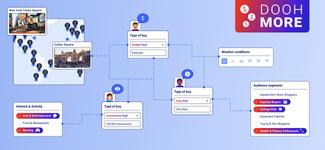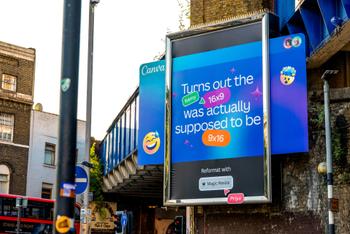According to GroupM’s 2024 End-of-Year Global Advertising Forecast, digital out-of-home (DOOH) advertising is projected to account for 42% of total out-of-home (OOH) ad revenue by the end of this year. One key factor of growth for DOOH is the integration of programmatic technology, allowing for real-time bidding and dynamic content delivery, enhancing targeting capabilities and operational efficiency.
As programmatic DOOH (pDOOH) only continues to grow in importance, we’re excited to unveil groundbreaking enhancements to Broadsign’s programmatic Supply-Side Platform (SSP), designed to modernize workflows, maximize revenue, and reinforce brand safety for our media owners. The introduction of our patent-pending AI Assistant, Broadsign Header Bidder Pro, and enhanced Competitive Separation features, is going to revolutionize the way you sell, manage and deliver programmatic DOOH campaigns.
Your AI Assistant has arrived
Unveiled at our annual customer summit, Broadsign Connect, in Barcelona, Spain, back in January, Broadsign’s AI Assistant is a patent-pending tool designed to reduce the time media owners spend on repetitive tasks. This includes reviewing, categorizing, and approving incoming ad creatives from programmatic bids sent through demand-side platforms (DSPs).
In 2024 alone, Broadsign media owners received between 32,000 to 43,000 unique OOH creatives each month that need to be manually reviewed and categorized. With that number expected to double this year, Broadsign’s AI Assistant will provide significant time and cost savings. As ad creatives are submitted to the Broadsign SSP, the AI Assistant sends an automated email with category and approval suggestions.
To ensure that it integrates seamlessly with your current review and categorization process, Broadsign’s AI Assistant learns your network’s unique categories to organize and review creatives. It will continue to learn and evolve over time, and you get to decide whether to use the AI Assistant to fully automate the process or to continue providing recommendations only.
By automating the categorization process, Broadsign’s AI Assistant can minimize common misclassification errors and quickly identify sensitive content that could hinder brand safety efforts. For instance, ads featuring alcohol on a screen near a school, or an ad that violates local laws like displaying a political ad next to a polling location, would be flagged by the AI Assistant with recommendations to reject the creative.
Priced-based auctions are now available with Header Bidder Pro
As part of the evolution of our Header Bidder offering, we’re excited to introduce the Broadsign Header Bidder Pro. As a refresher, we introduced our Header Bidder in 2022, which consolidates demand from multiple supply-side partners. This one-to-many programmatic approach allows media owners to simplify ad operations, maximize yield value, and increase fill rates.
With Broadsign’s Header Bidder Pro, you now have the ability to run price-based auctions, helping you get the most out of your programmatic campaigns through higher yields and fill rates, not to mention a simplified auction process. A key advantage of header bidding, or mediation layers, is the ability to consolidate your programmatic demand into one slot, freeing up valuable space on your network. You also get access to better content controls, creative caching, and synchronization capabilities that aren’t possible with container-based setups.
The combined benefits of Broadsign’s AI Assistant with Header Bidder Pro
As Broadsign’s AI creative assistant can categorize creatives more accurately, Broadsign’s header bidding solution will be able to easily match the right inventory with the right demand, resulting in higher-quality ad placements, improved buying satisfaction, and increased competition for premium inventory. Moreover, the combined features will facilitate the alignment of creatives with the varying compliance requirements across demand sources.
Enhanced brand safety for programmatic out-of-home campaigns
Broadsign media owners have long been able to set competitive separation criteria for directly sold campaigns. With this release, we’re excited to extend that capability to programmatic campaigns. More specifically, categories created in the Broadsign CMS will now sync with Broadsign programmatic and platform interfaces.
So, how does it work? Let’s say you have two fast food restaurants, neither of which want their ad to play next to each other. If these campaigns are booked directly, you can easily separate the campaigns with the existing capabilities mentioned above. However, if one – or both – campaigns were booked programmatically, there would have been no way to guarantee that the programmatic slot would not play next to the directly booked slot.
With Competitive Separation for programmatic campaigns, that’s no longer the case. The system will make every effort to prevent these two campaigns from playing one after another, regardless of channel: directly sold or programmatic. However, It’s important to note that competitive separation is only available for other SSP creatives if you are running Header Bidder Pro.
The combined benefits of Broadsign’s AI Assistant with competitive separation
With Broadsign’s AI Assistant, creatives can be categorized at a more granular level, identifying not just the brand but also its competitors and associated categories. The AI Assistant will also be learning directly from your existing categories and can apply your custom taxonomy onto your creatives, saving you time when approving creatives and automating the competitive separation process from programmatic back into your player.
It can also adapt and learn over time, recognizing nuanced relationships between brands and subcategories, such as differentiating between an “energy drink” and a “soft drink.” Moreover, as the AI creative assistant can enforce these competitive separation rules more effectively, advertisers will perceive your network as the more reliable option when it comes to protecting brand visibility and exclusivity.
How these enhancements will help you stay ahead in the rapidly evolving programmatic landscape
While these features were designed to solve a specific pain point at different steps of the pDOOH workflow, the real value comes from having these features work hand-in-hand for more efficient programmatic workflows, reduced errors, and to future-proof your programmatic revenue.
Broadsign’s AI assistant helps automate time-consuming tasks like categorizing creatives and identifying competing ads, allowing for faster decision-making within header bidding frameworks. Combine that with competitive separation, and you can guarantee strategic and compliant ad placements to advertisers.
Furthermore, failure to ensure competitive separation or effective creative categorization can lead to possible compliance violations, rejected bids, or damaged buyer relationships. Having all three features work together simultaneously can help minimize errors, ensuring a smooth and compliant workflow.
Finally, integrating these features into how you sell and manage pDOOH campaigns ensures that you stay ahead of the competition in today’s rapidly evolving programmatic landscape. Combining AI-powered categorization, header bidding, and competitive separation creates a robust ecosystem that drives revenue, enhances buyer trust, and delivers a superior user experience – all while operating at scale and with greater efficiency.






